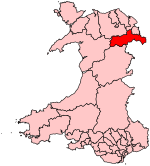Sun Bank Halt railway station
Disused railway stations in Wrexham County BoroughFormer Great Western Railway stationsPages with no open date in Infobox stationRailway stations in Great Britain closed in 1950Railway stations in Great Britain opened in 1905 ... and 2 more
Use British English from November 2017Wales railway station stubs
Sun Bank Halt in Wrexham County Borough, Wales, was a minor station on the Ruabon to Barmouth line. It opened as Garth & Sun Bank Halt but was renamed on 1 July 1906. The line was double track and there was never a signal box nor freight facilities here. On 7 September 1945, the bank of the Shropshire Union Canal failed, causing the trackbed to be washed away near the halt. A mail and freight train, hauled by GWR 4300 Class 2-6-0 No. 6315, was derailed, killing one person and injuring two people. A fire broke out, destroying all but the brake van of the train's consist.
Excerpt from the Wikipedia article Sun Bank Halt railway station (License: CC BY-SA 3.0, Authors).Sun Bank Halt railway station
A539,
Geographical coordinates (GPS) Address Nearby Places Show on map
Geographical coordinates (GPS)
| Latitude | Longitude |
|---|---|
| N 52.9726 ° | E -3.1296 ° |
Address
Sun Bank Halt
A539
LL20 8EG , Llangollen
Wales, United Kingdom
Open on Google Maps








